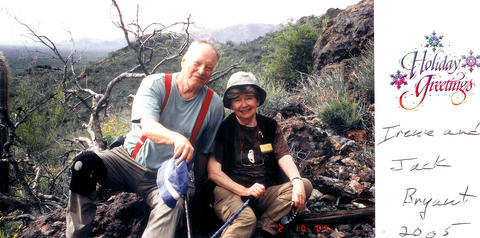Guilty of one murder, charged with another and linked to two more slayings, Gary Michael Hilton appears poised for infamy.
While he doesn't yet qualify as a "serial killer," the Atlanta-born transient captured the attention of FBI profilers within a week of his arrest for the decapitation of Buford, Georgia, hiker Meredith Emerson. They traveled from headquarters in Quantico, Virginia, to observe Hilton during questioning and again when he pleaded guilty Jan. 31 to the murder of Emerson, whom he abducted from Blood Mountain in North Georgia on New Year's Day.
If the evidence against Hilton - he was charged Thursday in the decapitation of Crawfordville, Florida, nurse Cheryl Dunlap - leads to more convictions, their research has only just begun.

PHOTOS: NY TIMES NEWS SERVICE
In anonymity, Hilton, 61, existed on the margins, drifting through a series of failed relationships, odd jobs and shiftless scams. The Army veteran never adapted to civilian life, often retreating to his van in the woods.
No longer anonymous, Hilton remains an enigma. His advanced age breaks the profiler mold, as serial murderers typically begin killing between 25 and 35 years of age, experts agree.
"This guy didn't just fall off the turnip truck and start doing this," said retired FBI profiler Clint van Zandt.

PHOTOS: NY TIMES NEWS SERVICE
Criminologist Eric Hickey, director of forensic studies at Alliant International University in Fresno, California, said he expects Hilton's predatory behavior began well before October, 2007, when the erstwhile subcontractor is alleged to have abducted and murdered avid hikers John and Irene Bryant. Transylvania (North Carolina) County Sheriff David Mahoney said there is "no question" Hilton was responsible for the elderly couple's deaths.
"It's almost unprecedented to see someone go from zero to what he did," Hickey said. "I'd suspect he could be linked to several other crimes."
Officials in Pickens County, South Carolina, are waiting until North Carolina completes its investigation of Hilton before pursuing him as a possible suspect in the abduction of Clemson University student Jason Knapp, last seen on Easter 10 years ago. Investigators said Knapp's fingerprints were on a ticket admitting him to Table Rock State Park.
Noel Talley, spokeswoman for the North Carolina Department of Justice, confirmed Hilton is a suspect in Rossana Miliani's disappearance but declined to offer more details. Miliani was last seen Dec. 7, 2005, near Bryson City, North Carolina Some said she was with a white man in his 60s, and the young woman appeared nervous.
Beyond his age, Hilton fits many of the characteristics shared by serial killers. Renowned criminologist Steven Egger's criteria include no relationship to the victim and a minimum of two murders, though some experts say three killings are a better indicator.
The slayings typically occur at different locales - Hilton is linked to crimes in three states so far - though the victims often share characteristics such as gender or age. The motivation is not financial, Egger said, though Hilton told the GBI that's why he killed Emerson.
"Money was a secondary issue," Hickey said. "This was about power. When you consider his comfort in the woods, that is where he felt most powerful, and that's why he killed them where he did."
Why he killed is the greater mystery.
At about the same time the Bryants were murdered, Hilton's life was changing dramatically. In September 2007, his longtime employer, John Tabor, succumbed to Hilton's demands for US$2,500.
Hilton's behavior had become increasingly erratic, Tabor said, and he paid him off in hopes of severing their already fractured relationship.
"This is systemic behavior with most of these guys," Hickey said. "He feels like the world is against him. There's issues of rejection, abandonment. Killing becomes his focus."
But Hilton got sloppy, especially in disposing of clues linking him to Emerson's death. He was arrested at a Chamblee gas station and convenience store near a busy intersection after being spotted dumping loads of sleeping bags, backpacks, bedrolls and blankets into a Dumpster.
"Narcissism is not uncommon for such antisocial personality disorders," said Joe Davis, a veteran profiler and forensic psychologist based out of San Diego. "He likes the attention he's getting."
While all four of the bodies Hilton could be connected with were left in dense forests, they were still somewhat conspicuous.
Hilton led authorities to Emerson's body on the condition they not seek the death penalty. Hunters in Florida and North Carolina, respectively, discovered Dunlap's and Bryant's corpses mere meters from unpaved hunting trails.
"I suspect he wanted them to be found," Hickey said. "He wants to be heard. He wants to frighten people. He wants to show his power. To him, it's really about having a voice."

This is the year that the demographic crisis will begin to impact people’s lives. This will create pressures on treatment and hiring of foreigners. Regardless of whatever technological breakthroughs happen, the real value will come from digesting and productively applying existing technologies in new and creative ways. INTRODUCING BASIC SERVICES BREAKDOWNS At some point soon, we will begin to witness a breakdown in basic services. Initially, it will be limited and sporadic, but the frequency and newsworthiness of the incidents will only continue to accelerate dramatically in the coming years. Here in central Taiwan, many basic services are severely understaffed, and

Jan. 5 to Jan. 11 Of the more than 3,000km of sugar railway that once criss-crossed central and southern Taiwan, just 16.1km remain in operation today. By the time Dafydd Fell began photographing the network in earnest in 1994, it was already well past its heyday. The system had been significantly cut back, leaving behind abandoned stations, rusting rolling stock and crumbling facilities. This reduction continued during the five years of his documentation, adding urgency to his task. As passenger services had already ceased by then, Fell had to wait for the sugarcane harvest season each year, which typically ran from

It is a soulful folk song, filled with feeling and history: A love-stricken young man tells God about his hopes and dreams of happiness. Generations of Uighurs, the Turkic ethnic minority in China’s Xinjiang region, have played it at parties and weddings. But today, if they download it, play it or share it online, they risk ending up in prison. Besh pede, a popular Uighur folk ballad, is among dozens of Uighur-language songs that have been deemed “problematic” by Xinjiang authorities, according to a recording of a meeting held by police and other local officials in the historic city of Kashgar in

It’s a good thing that 2025 is over. Yes, I fully expect we will look back on the year with nostalgia, once we have experienced this year and 2027. Traditionally at New Years much discourse is devoted to discussing what happened the previous year. Let’s have a look at what didn’t happen. Many bad things did not happen. The People’s Republic of China (PRC) did not attack Taiwan. We didn’t have a massive, destructive earthquake or drought. We didn’t have a major human pandemic. No widespread unemployment or other destructive social events. Nothing serious was done about Taiwan’s swelling birth rate catastrophe.